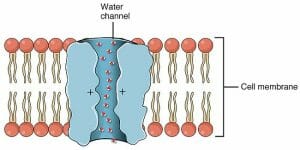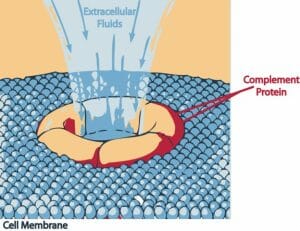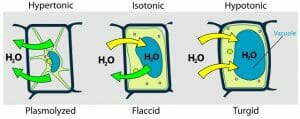Cytolysis Definition
Cytolysis, also known as osmotic lysis, occurs when a cell bursts and releases its contents into the extracellular environment due to a great influx of water into the cell, far exceeding the capacity of the cell membrane to contain the extra volume. This is a concern particularly for cells that do not have a tough cell wall to resist internal water pressure.
Water can slowly diffuse across the lipid bilayer of the cell membrane but rapid transport requires the presence of selective transmembrane channels called aquaporins. These integral membrane proteins allow movement of water while preventing access to many solutes and ions.

Cells usually have a higher salt and ion concentration than their immediate environment, especially in single celled organisms that live in fresh water bodies and this can lead to the influx of water. Most cells have internal mechanisms to deal with constitutive movement of water. However, when there is a sudden change in the tonicity of the extracellular environment, or a change in the membrane structure, water can flood the cell and cause it to burst.
The image shows the impact of extracellular ion concentration on the cell structure. Cytolysis is a cause of cell death in multicellular organisms when their body fluids become hypotonic and is seen as a side effect of suffering from a stroke. Osmotic lysis is also used by some replicated viral particles to exit their host cell and continue the infective process.
However, cytolysis has a functional role as well and is used by the immune system to selectively destroy tumor cells or those infected by some pathogens.
Types of Cytolysis
Cytolysis can be caused by many factors, from the tonicity of the extracellular fluid to the activity of other cells affecting the structure of the cell membrane.
Cytolysis by Hypotonic Environment
When cells are placed in a pure water environment, water floods the cell and causes it to burst. For instance, red blood cells will undergo hemolysis when placed in distilled water and this can be measured from the appearance of hemoglobin in the solution. A solution containing 0.9 gms of sodium chloride (NaCl, or common salt) in 100 ml of water is considered isotonic, or containing the same salt concentration as the interior of a red blood cell. Solutions with lower salt concentrations will cause these cells to burst. Therefore, intravenous injections of pure distilled water can be extremely harmful, especially to the fragile cell membranes of erythrocytes or red blood cells.
Cytolysis by Pathogens
Viruses are highly specific in their choice of host. In addition, most of them are adapted to infect not just a particular organism but specific cell type within the host. Viruses cannot function outside their host and need to hijack the cellular machinery to undergo metabolism and initiate reproduction. However, after multiple rounds of duplication, the presence of virion particles can overwhelm the host cell. At this point, viruses can compromise the cell membrane in a manner that leads to water ingress and eventual cytolysis. Once the cell undergoes lysis, viruses are released allowing them to repeat the infective cycle with new host cells in the same tissue.
The specificity of viruses for their host can potentially be exploited in cancer therapy. The phenomenon of viruses inducing a remission from cancer has been observed since the 1800s. Many viruses preferentially infect cancer cells while leaving normal cells intact because malignancy damps the antiviral response of a cell. These viruses can induce cytolysis in tumor cells and thereby contribute towards treatment. In 2011, a virus particle was reported as inducing cytolysis in tumor cell lines, tumor initiating cells as well as primary tumor tissue from patients. In 2015, the US FDA approved the first viral melanoma therapy.
Bacterial cytolysis has been observed due to an overgrowth of lactobacilli in the vagina. The vagina of adult women is normally colonized by lactobacillus and, in low numbers, these bacteria protect against fungal infections. However, some women present symptoms of fungal infection that is resistant to treatment by antifungal drugs. In these cases, women having heavy discharge, itching and no pathogenic bacteria or fungi in wet smears also show an increased abundance of lactobacilli. The discharge is caused by cytolysis of vaginal epithelial cells due to bacterial infection by lactobacilli.
Cytolysis by the Immune System
The immune system uses a variety of methods to induce cytolysis –in pathogens as well as in infected or cancerous cells in the body. Among the most potent mediators of cytolysis in the immune system are the T-cells and Natural Killer (NK) cells. Both these cells can either induce a cell to undergo apoptosis or release proteins called perforins that form channels on the cell membrane. When water enters the cell through these channels, it undergoes osmotic lysis. In addition, NK cells can also act through the adaptive immune system, interacting with T-cells as well the antibodies released from B cells. Through the antibody and complement system, pathogenic cells can be lysed through the formation of a ring-like transmembrane structure on the cell membrane by complement proteins.

This method of cytolysis can lead to a major complication when there is histoincompatibility between a mother and fetus. When one particular type of antibody (IgG) passes through the placenta and recognizes antigens on fetal blood, it can activate the complement system as well as innate immunity causing those red blood cells to undergo hemolysis. The child is born with jaundice-like symptoms.
Natural Killer Cells are also crucial for the body’s defense mechanism against tumor formation. When cancerous cells downregulate the expression of surface antigens, powerful cells of the adaptive immune system cannot recognize these cells or mount an immune response against them. NK cells can activate an inflammatory response, attract other cytotoxic cells and together induce either osmotic lysis or apoptosis on tumor precursor cells.
Functions of Cytolysis
Cytolysis is often used as a tool of survival by various cells. While single celled organisms and pathogens use it to repel attack or gain access to new hosts, multicellular organisms use cytolysis during an immune response or in order to remove damaged and dangerous cells from within their body.
Prevention of Cytolysis
In spite of its many uses, it is important for an organism to control when and how cytolysis occurs. Plants have a natural defense mechanism against cytolysis because they contain a tough cell wall. When a plant cell is placed in a hypotonic environment and water rushes in, the cell wall exerts an opposing pressure on the cell membrane, preventing it from expanding or rupturing. In a hypertonic environment, the cell undergoes loss of water, also known as plasmolysis. In an isotonic solution, there is an equal amount of water entering and exiting the cell, leaving its overall volume intact. In hypotonic solutions, as water enters the cell, the vacuole takes up much of the excess water, protecting the cytoplasm from dilution.

The cell wall also creates a reverse pressure, causing water to leave the cell, while maintaining optimal turgidity. This turgidity allows plants to remain upright in the absence of an internal skeletal system.
Single celled protists like amoeba and paramecium contain an organelle called the contractile vacuole that is involved in preventing cytolysis. It is a pulsing structure that undergoes repeated cycles of diastole (water entering the vacuole) and systole (water being pumped out of the cell). The exact mechanism of these contractions is not known, but these organelles seem to be functioning even when cells are placed in a solution with high salt concentration.
Multicellular organisms usually have a sophisticated mechanism to ensure that all their cells are bathed in an isotonic solution. In humans and other mammals, this is the excretory organ system formed by the functional units of nephrons in the kidney. As blood is filtered in the kidney, salts, ions, waste products, ammonia and excess water is removed and expelled at regular intervals, allowing the organism to maintain homeostasis. If there is an increase in water intake, there is a concomitant increase in water removal through the excretory system. This system is under the regulation of an elaborate network of hormones and other physiological responses and ensures that all the cells within the body are primarily exposed to an isotonic extracellular fluid. Cells present on the interface with the outside world – whether on the skin or lining the digestive system – are protected from cytolysis through a hydrophobic layer made of either oils or waxes.
Occasionally, the excretory system is overwhelmed when an organism suddenly imbibes a large quantity of water in relation to the salt reserves of the body. This is called water intoxication and the symptoms arise from the effect of cytolysis in the cells of the brain.
Related Biology Terms
- Adaptive Immune System – A subset of the immune system in vertebrates that is capable of immunological memory. Second and subsequent exposures to a particular pathogen evoke quick, specialized responses.
- Crenation – Contraction of a cell after exposure to a hypertonic solution.
- Tonicity – A measure of the relative concentration of solutes in two solution separated by a semi-permeable membrane. Tonicity determines the direction and extent of diffusion across the membrane.
- Turgor Pressure – Pressure of water pushing the cell membrane against the cell wall of a plant cell.
Quiz
1. Which of these solutions will cause cytolysis in red blood cells?
A. 0.9% NaCl
B. 1.5% NaCl
C. 0.4% NaCl
D. Sea water
2. Which of these DOES NOT induce cytolysis?
A. Placing cells in a hypertonic environment
B. Action of perforins on cell membranes
C. Activity of membrane attack complex by complement proteins
D. Disruption of membrane structure by viruses
3. Which of these methods is used by amoeba to prevent cytolysis?
A. Cell wall
B. Excretory organ system
C. Contractile vacuole
D. All of the above

